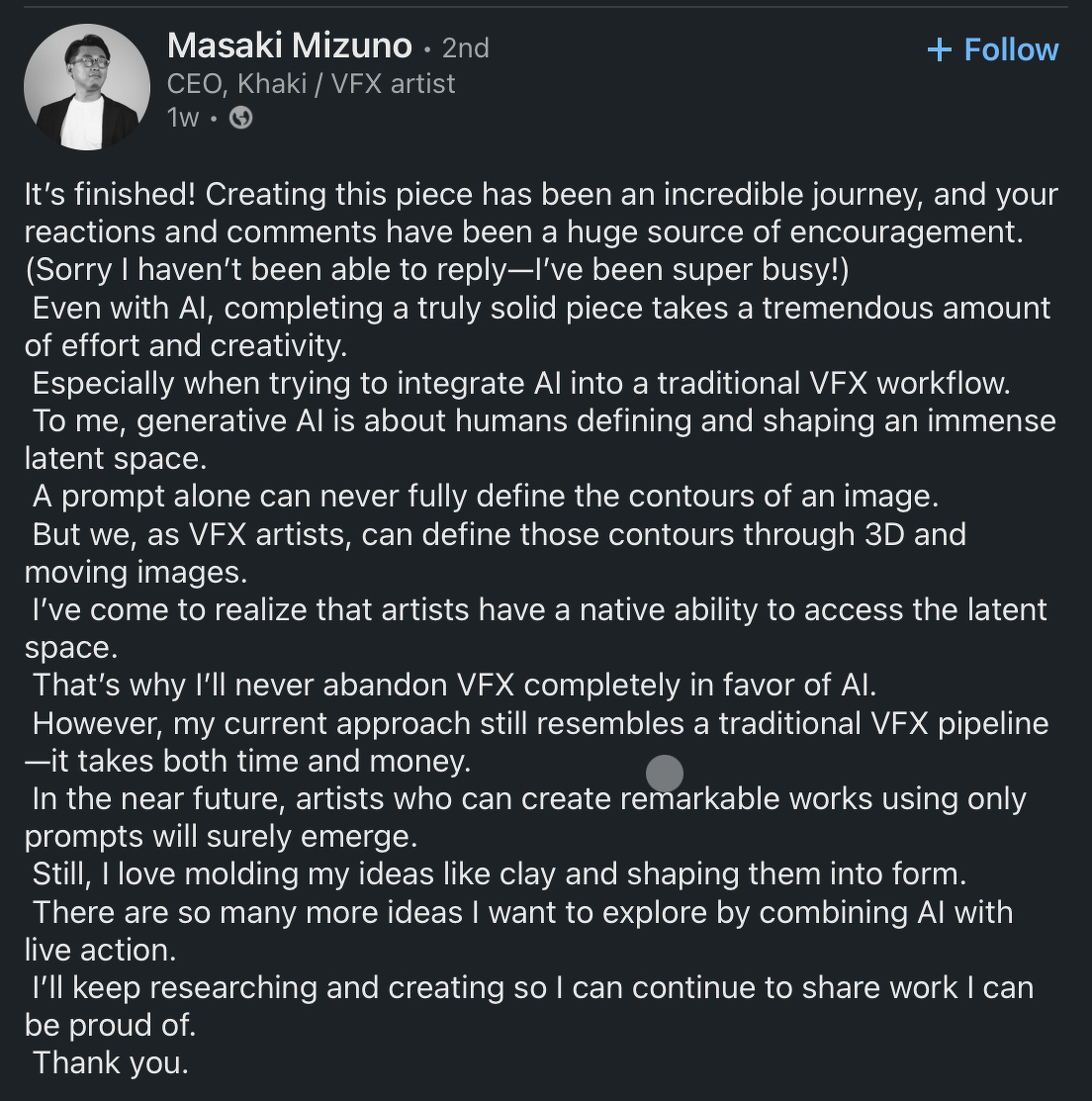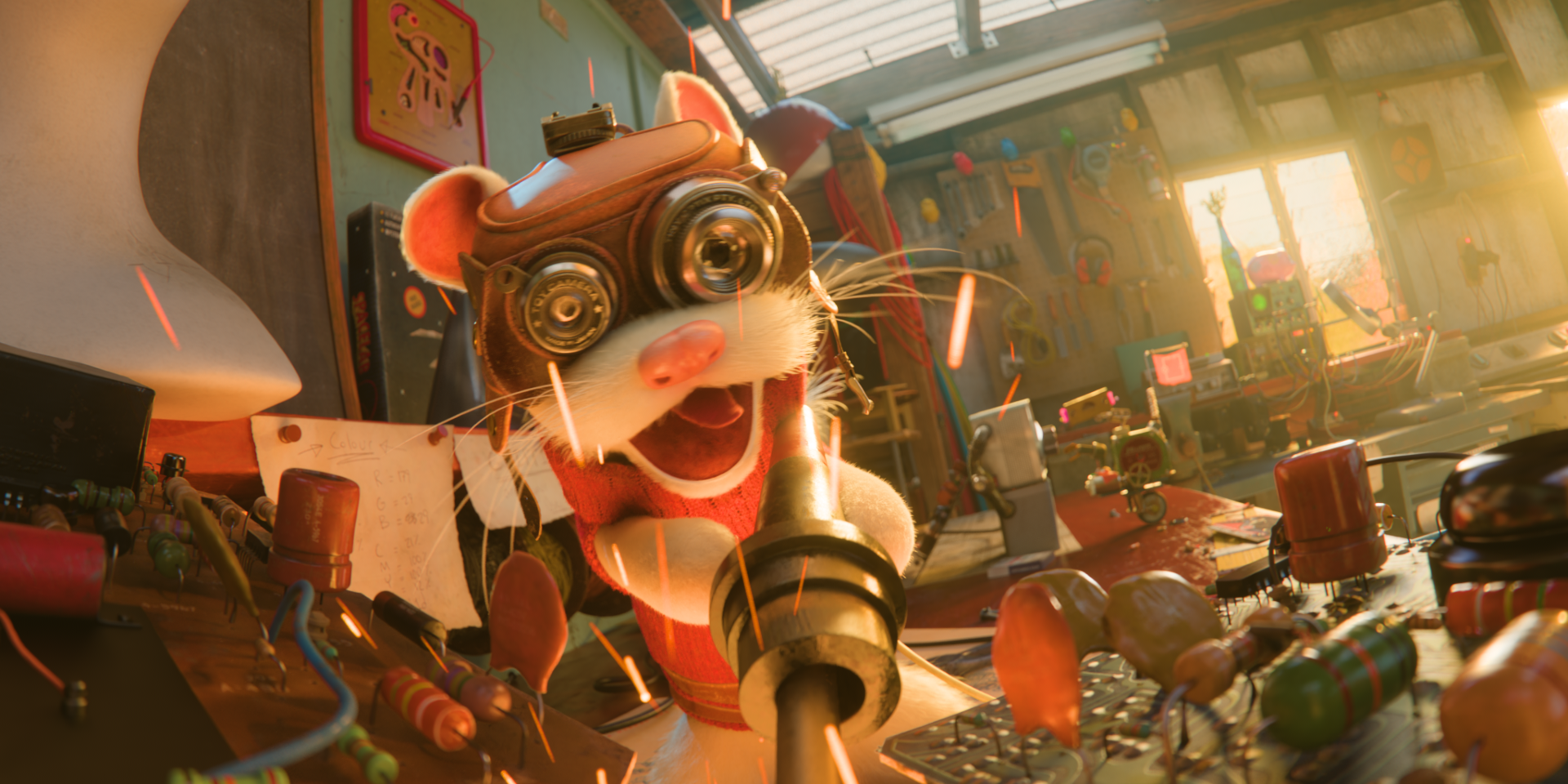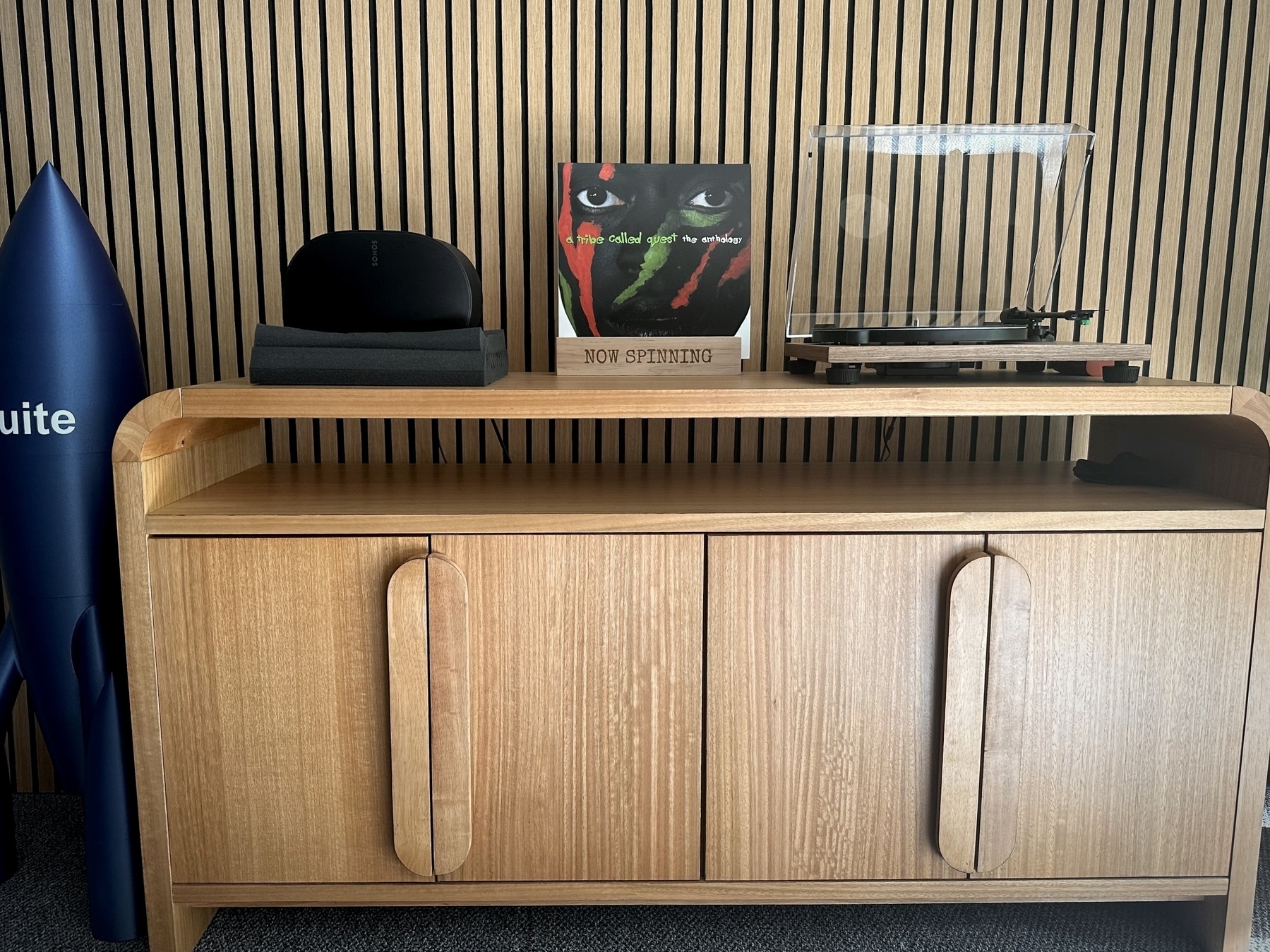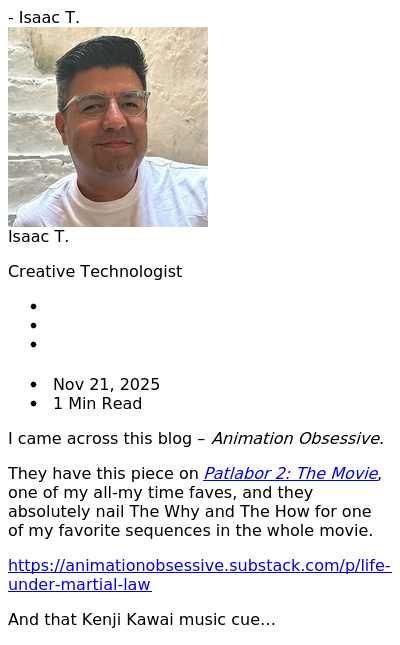Hey you! Get your isaact.co merch here:
And some recent articles that’ll pair nicely with your new gear:
- On DaVinci Resolve: Local, Cloud, and Network Project Libraries
- DaVinci Resolve: Optimizations and Workflows
Represent!
I came across this blog – Animation Obsessive.
They have this piece on Patlabor 2: The Movie, one of my all-my time faves, and they absolutely nail The Why and The How for one of my favorite sequences in the whole movie.
https://animationobsessive.substack.com/p/life-under-martial-law
And that Kenji Kawai music cue… 🤌🏽🤌🏽
WAVE by Masaki Mizuno, CEO of Khaki
Here are some Making Of… comments from the artist:

The last time I felt this way about something was when Spike Jonze made an ad for KENZO.
DOING DETECTIVE WORK WITH DTRACE (OPENSNOOP AND RWSNOOP)

If you’ve ever wondered:
- What happens when I launch my app?
- What is my app doing right now?
- Why is my app taking so long to do something?
Then you’ll want to know a little bit about using DTrace.
If you’re an artist or creative professional, DTrace itself might feel a bit tricky to use. Thankfully, some helper apps exist to make it more approachable.
Let’s talk about two of them:
opensnooprwsnoop
We’ll use these helper apps to answer those questions using one popular app: Adobe Premiere Pro (25.5, as of this writing).
Using macOS? Let’s start by making sure you can actually run DTrace.
Enabling DTrace in macOS
Using DTrace or any of its related apps means you’ll be using a command line in Terminal.app.
If you try using opensnoop straight away, you’ll learn:
DTrace requires additional privileges- you’ll need access to a local Administrator account’s password.- DTrace requires you to disable System Integrity Protection (SIP) on your Mac.
If that scares you a little, it should (a little).
But fear not.
Did you know you can selectively disable SIP for DTrace usage?
csrutil enable --without dtrace
Once you add this exception to your Mac’s SIP, restart, log back in, and confirm you successfully modified SIP with this command:
csrutil status
If it was successful, you’ll see a System Integrity Protection status: unknown (Custom Configuration) report with DTrace Restrictions: disabled.
And when you’re finished using anything DTrace-related? Head back into Recovery mode and fully reenable SIP on your Mac.
csrutil enable
Now you’re ready to see some stuff.
opensnoop
I work with a lot of Premiere Pro teams these days.
They frequently ask:
What is Premiere Pro doing right now?
opensnoop may give you some answers.
What does opensnoop do? (In Terminal, man opensnoop, then press Return)
Snoop file opens as they occur. Uses DTrace.
How do you use it?
- If Premiere Pro is open, save any open work and quit Premiere Pro.
- Launch
Terminal.app. - Resize that Terminal window to be as wide as possible.
- Copy/paste this command and press
Return:sudo opensnoop -v -n "Adobe Premiere Pro 20XX"(where XX is the year of Premiere Pro you’re using) - Launch Premiere Pro, and you’ll see that Terminal window start scrolling (and scrolling) with lines of information.
What can you learn?
- While Premiere Pro is launching – you’ll see what it initially opens as part of its app resources: fonts, Motion Graphics Templates (
.mogrt), etc. - When you open a Project – the full path to your
.prprojwill appear. Also, ifEnable project lockingunderPreferences > Collaborationis checked, you’ll see the path to that.prlockfile appear shortly thereafter. - While playing back a Clip or Sequence – the full path to the underlying media will appear.
How could this be helpful?
Some have asked me, “If I work with proxy media, does Premiere Pro open both the original media and the proxy media at the same time?”
Using opensnoop, you’ll find the answer is, “No.”
Try this:
- In Premiere Pro, make a Sequence with one Clip based on your original media.
- Use your favorite encoder/transcoder app to create a proxy media file. Make sure to name that file with something like “_Proxy” at the end.
- In Premiere Pro, attach that proxy media file to your Clip.
- Find the
Toggle Proxiesbutton in yourProgramorSource Monitorand toggle it On.
Play your Clip or Sequence, and you’ll see the full path to your proxy media appear. You can even Toggle Proxies On or Off during playback, and see Premiere Pro changes which media file it’s using on playback.
Does this feel like a Rube Goldberg device for something simple? Perhaps.
But you can Toggle Proxies with or without proxy media attached to your Clips, and Premiere Pro will playback your Clip or Sequence without any clear indication of whether proxy media is attached or not.
And, yes, you can enable three Bin columns (Control-click on a Bin column, choose Metadata Display…, search for “Proxy”) to help you see if proxy media is attached. But I’ve yet to meet a Premiere Pro user who knew about those columns without a web search.
So if you want the definitive answer to, “Is Premiere Pro playing my original or proxy media?”, use opensnoop. It’s worth the effort.
But some apps won’t allow opensnoop to do its thing. What then?
rwsnoop
rwsnoop can provide some clues when opensnoop can’t.
What does rwsnoop do? (man rwsnoop, then press Return)
snoop read/write events. Uses DTrace.
How do you use it?
- Launch
Terminal.app, or create a new Terminal window (Command-N). - Copy/paste this command and press
Return:sudo rwsnoop -v -n "Adobe Premiere Pro 20XX"(where XX is the year of Premiere Pro you’re using) - If it’s not open, launch Premiere Pro.
What can you learn?
rwsnoop will show you which files are being read (R) or written (W) in the D (for Direction - read or write) column.
You’ll also see how many BYTES of that file were read or written.
Unlike opensnoop, rwsnoop won’t display the full path to the file being read. But if you want a clear, focused view of which media files Premiere Pro references during playback, you can Toggle Proxies On or Off during playback, and you’ll see a tidy list of filenames Premiere Pro is referencing here.
Questions
Where can I find the correct process name to feed opensnoop and rwsnoop with -n?
- Launch
Activity Monitor.app. - In Activity Monitor, search for the name of your app, then double-click the name in the list.
- Locate the
Executable Path. The last item in the path is the process name you’ll use after-n.
Can I save opensnoop and rwsnoop results to a file?
Yes!
Just add this to the end of the command…
> ~/Desktop/NameOfApp_Results.txt
…and you’ll see a text file appear on your Desktop.
For example:
sudo opensnoop -v -n "Adobe Premiere Pro 20XX" > ~/Desktop/PremierePro2025_Results.txt
However, anecdotally it seems DTrace won’t record all events to a file as it would if you were monitoring its output in Terminal.
You can use the excellent (and free) TextMate editor to open and live monitor this text file as opensnoop or rwsnoop writes to it.
Where can I find more DTrace helper apps/scripts?
In Terminal, copy/paste this command, and press Return:
apropos dtrace
Credits
If you get to the bottom of any man page for a DTrace script, you’ll see this name: Brendan Gregg.
We’ve never met, but thank you, Brendan, for all of your work over the years to make DTrace more approachable and useful for macOS users:
Also, check out this article by Colin Jones – A Few DTrace Gotchas and Workarounds on OS X:
https://8thlight.com/insights/a-few-dtrace-gotchas-and-workarounds-on-os-x
- Particularly this section: SIP Strikes Back.
We’ll use this to look at why opensnoop won’t do the detective work on certain apps in a future installment. ✌🏽
DJV - AN IMAGE SEQUENCE VIEWER AND COMPARISON TOOL BY DARBY JOHNSTON
Ever needed to open an OpenEXR sequence before? Chances are, you’ve heard of RV and Open RV. But have you tried DJV?
Written and maintained by Darby Johnston (a Lucasfilm alumnus) DJV lets you open, compare, and review OpenEXR sequences…
…and more.
- Timeline support with OpenTimelineIO
- Color management with OpenColorIO
- Multi-track audio with variable speed and reverse playback
- Experimental support for USD files
Like Open RV, it’s part of the Academy Software Foundation.
Unlike Open RV, you don’t have to build it from source (unless you want to 😄). Darby provides builds for macOS, Windows, and Linux.
Need a test EXR sequence? The ASWF has you covered there too:
- NAS Sole Mates: https://dpel.aswf.io/solemates/

MDVx was quietly updated back in September. Update now before your annual sojourn to that favorite cabin in the woods.


D’Angelo’s music literally changed my life.
Tron: Ares… saw it yesterday in a real IMAX.
I enjoyed it. Still thinking about it.
If you’re a TRON fan, try to avoid the interviews and surrounding media and see it in the largest theater possible. Completely worth it.
Being a self-described Man of No Nation, I can’t explain it, but this SNL piece scratches a very specific itch in my brain:
Also if you’re ever in Las Vegas, it’s a primer for your next visit to this exceptional Mexican restaurant:
Pro Tools user on macOS? Commit this name to memory: Pete Gates.
Pete makes three phenomenal helper apps for Pro Tools:
-
PG PT Prefs - petegates.com/pgptprefs…
-
PG PT Session - petegates.com/pgptsessi…
-
PG PT WAV Checker - petegates.com/pgptwav.h…
These apps are inexplicably free and extremely useful. But if you’re looking for a worthy place to donate funds, just hit the button at the bottom of Pete Gates' site.
I feel like I owe a lot to TRON. If TRON didn’t exist, I’d be in another line of work.
So Joachim Rønnning and team, I’m rootin’ for you. Hoping to see it in IMAX on (or close to) opening night. 📽️🍿
Light Cycle c/o Joseph Terronez.


SOL LEVANTE - A NETFLIX X PRODUCTION I.G COLLAB TO ADVANCE HDR AND 4K (AND BEYOND) WORKFLOWS
Still can’t believe Netflix worked with Production I.G on producing a short to push HDR and 4K workflows forward in Japanese animation.
And the final elements of the project (like Pro Tools Sessions and media) are available to view and download. (Perfect for testing file streaming on cloud storage. 😉)
Bringing 4K and HDR to Anime at Netflix with Sol Levante
netflixtechblog.com/bringing-…
(Shout out to Haruka Miyagawa & Kylee Peña!)
The Making of Sol Levante, a 4K and HDR hand-drawn anime short
Both Haruka & Kylee said this project was likely overshadowed by the COVID-19 pandemic (this article was published in April 2020), so here’s a direct download link to the Sol Levante assets and a link to the Netflix Open Connect site with even more projects.
I wish people would watch Light & Magic on Disney+ all the way through.
T2norway’s Japanese Music Discoveries series.
3 volumes.
3 years in the making.
This is how you do it.
Also see:
Slaps.
Went to HQ this week in Colorado. Hung out with some great people, inside and outside our team.
The day before I went back to New York, Craig Hering drops this on the office.
Suite Studios represent. 🎧

Hello! I’ve been swimming in workflows for weeks now, but a couple recent highlights from the realm of Suite Studios:
-
This lovely report by Kevin P. McAuliffe on his Suite experience: www.provideocoalition.com/in-depth-…
-
It’s official! You can use PostLab Pro on Suite: docs.hedge.video/postlab-1…
If you’re using Premiere Pro 25.2.x and you get a dialog box or a warning in your sequence that says:
Can’t access audio
The audio for {Filename} can’t be read quickly enough from storage. Please check your storage and try again.
It’s a known issue and Adobe’s addressing it.
The workaround?
- Uninstall Premiere Pro
25.2.x. - Reinstall Premiere Pro
25.1or earlier. - (Optional) Disable Auto-Update for Premiere Pro:
Creative Cloud > Preferences > Apps > Auto-update > Premiere Pro: Toggled to Off
More details in this Adobe Community thread:


ISAAC T.’S POST-NAB 2025 HIGHLIGHTS
I joined Suite Studios back in February and let me tell you – I’m enjoying the ride.
This past week I found myself somewhere I never thought I’d be again: The NAB Show in Las Vegas.
As always, to all of you who stopped by the booth: thank you.
ICYMI, here’s what we showed our guests:
- A super-fresh UI refresh 🧊
- The Global User Model - one team member can now belong to multiple teams.
- Instant Install - no more macFUSE, no more Benjamin Fleischer.
- Instant Archive - move files you aren’t using right now to a special folder, and boom: it’s archived. That’s it. Anything in your team’s Instant Archive folder will be billed at a reduced rate.
- On-Site Cache - use your on-prem shared storage to share a Suite cache among your team for extra performance when working from Suite inside your facility.
- Suite Connect - give non-team members the ability to upload and download files to / from Suite.
All from the comfort of an inviting booth, a series of speakers made up of our insanely talented customers, and the delightful aroma of fresh popcorn.
And then, Suite won Product of the Year. Mind. Blown.
Frequently Asked Questions
The great part about being at a show is you hear from people in the moment, and a few thoughts or questions persistently pop up. Here are a few:
Is Suite’s cache encrypted?
Are you transcoding my files when I upload those to Suite?
No. Suite is truly a filesystem – whatever you upload to Suite is uploaded as-is. None of your files are transcoded or recompressed. That’s the magic of Suite’s file streaming: upload your files, press Spacebar, and go to work.
Doesn’t Suite require macFUSE (Benjamin Fleischer)?
Nope! Not anymore. 🙂
Still skeptical? Sign up for a 14-day trial and battle test Suite. You’ll get unlimited storage and unlimited users during your trial. If you run into any trouble, we’ll be there.
Restaurant Recommendations
Secret Pizza - I introduced the whole team to some proper slices at the Cosmopolitan. It was even better than I remember.
TAO Asian Bistro - if you can go, go. 🤤
Lardo - I split a sandwich with my buddy Colin. He had a birria-based grilled cheese and I had the porchetta. Perfection.
There’s so much more to come for Suite in 2025 – stay tuned!
For now, I’ll leave you with this snapshot where we all had a moment of respite before the big week. Looking forward to doing it all over again with these fine people. See you then!

Now available – Final Cut Pro 11.1
Of course, Chris Hocking at fcp.cafe has you covered with his own deep dive plus links to even more coverage:
https://fcp.cafe/news/20250328/
Happy to have Apple silicon just for FCP and Motion. 👌🏽
DOGEARS - BENCHMARKING PERFORMANCE IN PREMIERE PRO

Like the Quesarito at Taco Bell, DogEars is a hidden menu item in Premiere Pro.
With DogEars you can get a frame-by-frame, blow-by-blow look at how well a Clip is playing back something in Premiere Pro.
How do you enable DogEars?
- macOS -
(Command-Shift-Fn-F11)or just(Command-Shift-F11) - Windows -
(Control-Shift-F11)
You can also enable DogEars by:
- Invoking Premiere Pro’s Console (
Command-Fn-F12orControl-F12). - Clicking the hamburger menu next to
Consoleand chooseDebug Database View. - Search for
DogEars. - Click the ☑️ next to
EnableDogEarsso the value turns totrue.
Once you enable DogEars, press Spacebar or the play button for a Clip or in your Sequence and Premiere Pro will display those playback statistics on top of what you’re currently playing.
💡Premiere Pro will only reveal those statistics from DogEars once you press
Spacebaror the play button. Conversely, if you disable DogEars, Premiere Pro only hides those stats once you pressSpacebaror ▶️.
If you look up anything on using DogEars, you might find something from members of the Premiere Pro team stating, “Dog Ears is an engineering tool, which is not meant to be accessed by users.”
OK.
Well, if you’ve ever used something like MediaInfo, DogEars is like that… in real time for Premiere Pro.
How do you read DogEars output? I won’t take you item by item, but Dell published a pretty handy guide for how to read these as part of their Isilon: Adobe Premiere Pro Configuration and Optimization paper on pages 13 through 18. (Seriously, it feels a lot like reading MediaInfo.)
Why would you use DogEars? You might want to see how well Premiere Pro plays back something from a particular type of storage.
And if you’re ready to boost your team’s Premiere Pro workflow with some cloud storage built for file streaming, I know some people. 😄
Did iOS and iPadOS 18’s Show Vehicle Motion Cues make one of the recent keynotes?
Settings > Accessibility > Motion > Show Vehicle Motion Cues
Been using it for the past few weeks.
Buried. Treasure.
I just discovered a VFX Compositor is selling instructional materials for up-and-coming visual effects workers under this moniker – Pixelfudger.
This makes me sad because either:
- They haven’t seen Hollywood’s Greatest Trick and don’t… know what this really means.
- They have, they’ve given up on change, and they’re trying to normalize this term with humor.


















